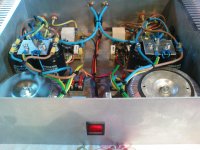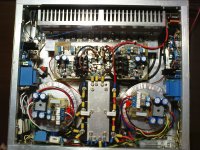Hi,
it was in the DC servo thread.
I have repeated the main content here.
But do go back and read the DC servo thread. It will teach you a lot.
it was in the DC servo thread.
I have repeated the main content here.
But do go back and read the DC servo thread. It will teach you a lot.
Well,
Checked the voltage across both LED's, and they measured 1,765 and 1,766 Volts each. Considering I only have a relatively modest multimeter, I interpret this as being simmilar values.
I allso hooked the old scope to the output, and sweeping through the time-div range, I could not see any AC components indicating oscilation.
Now what to do...
Checked the voltage across both LED's, and they measured 1,765 and 1,766 Volts each. Considering I only have a relatively modest multimeter, I interpret this as being simmilar values.
I allso hooked the old scope to the output, and sweeping through the time-div range, I could not see any AC components indicating oscilation.
Now what to do...
,
Now what to do...
Either check if the differential pairs transistors
are matched or extend the DC servo correction range....
I would start with the former..
In general, I agree to the approach as I am still holding on to the assumption that this amplifier should work with the DC servo that was originally designed and tested with it (by elektor) in the first place..
Now, I didn't match the transistors in any way as this was not called for in the article describing the project. I believe that if this was critical, it would have been highlighted.
So how do I check the differential pair transistors T1-4? Just removed the metal clips keeping the pairs clamped together and checked confirmed that they were of the correct type, so no component mix-up there..
Is there any voltages I can/ should check?
Now, I didn't match the transistors in any way as this was not called for in the article describing the project. I believe that if this was critical, it would have been highlighted.
So how do I check the differential pair transistors T1-4? Just removed the metal clips keeping the pairs clamped together and checked confirmed that they were of the correct type, so no component mix-up there..
Is there any voltages I can/ should check?
In general, I agree to the approach as I am still holding on to the assumption that this amplifier should work with the DC servo that was originally designed and tested with it (by elektor) in the first place..
?
Designed by Elektor doesn t mean it is flawless...
Many of their amps did have issues that were later corrected.
The highly regarded original Crescendo or their LFA were both
prone to oscillations..
True, there is no guarantee that a published DIY project is flawless or can not be improved uppon.
I have heard that the older Crescendo versions vere notorious for oscilation, but I have not found referance to any typical issues for The Crescendo ME edittion...😕
Anyway, as it seems it wasn't the servo circuit after all, I now need to scrutinize my amplifier cards..
I have heard that the older Crescendo versions vere notorious for oscilation, but I have not found referance to any typical issues for The Crescendo ME edittion...😕
Anyway, as it seems it wasn't the servo circuit after all, I now need to scrutinize my amplifier cards..
Use a multimeter to check the Vbe of the differentials.
With some prudence, you can make it in situ using voltmeter function,
inserting two 1K resistor in serial at the extremity of the multimeter leads,
or either unsold them and then test them with the diode function.
Use preferably the latter method.
T1/T2 must have matched VBE
as well as T3/T4, preferably at 5% variation at most..
With some prudence, you can make it in situ using voltmeter function,
inserting two 1K resistor in serial at the extremity of the multimeter leads,
or either unsold them and then test them with the diode function.
Use preferably the latter method.
T1/T2 must have matched VBE
as well as T3/T4, preferably at 5% variation at most..
Last edited:
T1/T2 must have matched VBE
as well as T3/T4, preferably at 5% variation at most..
wahab
absolute correct .
I made two times Crescendo Millennium and i dont have any problem .
dc offset without dc servo 1,7 volt with dc servo 3-5mv
I measure 35 pk -pk before clip with 45 mv idle current stable all ambient temperature 22-35 C
also i made two times TITAN 2000
best regards nikos
as well as T3/T4, preferably at 5% variation at most..
wahab
absolute correct .
I made two times Crescendo Millennium and i dont have any problem .
dc offset without dc servo 1,7 volt with dc servo 3-5mv
I measure 35 pk -pk before clip with 45 mv idle current stable all ambient temperature 22-35 C
also i made two times TITAN 2000
best regards nikos
Attachments
this is bonkers.I made two times Crescendo Millennium and i dont have any problem .
dc offset without dc servo 1,7 volt with dc servo 3-5mv
as the amp starts up it is going to approach 1.7V of output offset.
The DC servo will start measuring that output offset and after the filter delay start applying a correction voltage to try to cancel out the excessive output offset.
You have a problem. Fix your amplifiers.
this is bonkers.
as the amp starts up it is going to approach 1.7V of output offset.
You have a problem. Fix your amplifiers.
There s no problem , at least not a big one..
The amp has a dc coupled feed back network, that is,
it has DC voltage gain of 26.5...
Adding the usual DC blocking cap in the said FB network would
yield a 65mV output offset without the DC servo..
Not an extraordinary value, but still acceptable..
Last edited:
Thank you for yet more advice on how to progress!
I'll clamp some 1 k resistors to the test leads and measure the voltage directly over Basis-Emitter on the card with the amp powered up, hopefully, that may provide a clue to what's going on...
Oh, one thing.. Should I do this with the servo disconnected and R2 12k and the 220uF cap in series with R22, or should I solder things back and hook up the DC servo connection?
I'll clamp some 1 k resistors to the test leads and measure the voltage directly over Basis-Emitter on the card with the amp powered up, hopefully, that may provide a clue to what's going on...
Oh, one thing.. Should I do this with the servo disconnected and R2 12k and the 220uF cap in series with R22, or should I solder things back and hook up the DC servo connection?
Last edited:
Nikosokey, good to hear from someone that has actually buildt the amp and had it work!
Did you look at the DC-offset before adjusting the bias current with the pot on the amplifier card?
Did you look at the DC-offset before adjusting the bias current with the pot on the amplifier card?
Well,
Before having a go at measuring Basis-Emitter voltage for T1-4 on the card, I decided to test some of the transistors left over from the bag I bought.
With the diode test function on my multimeter, I got 0.94V across B-E.. is this a bit high? As I read the data-sheet for BC-546B, the voltage should be 0,7.
Could I have gotten a batch of bad/ out-of-spec transistors???
I allso used the hFE function, and got values of around 350 for the BC-546B (T1-2), whilst the data sheet specifies 500, and for the BC-556B (T3-4) I got 250 whilst the spec says 200-400
😕
Before having a go at measuring Basis-Emitter voltage for T1-4 on the card, I decided to test some of the transistors left over from the bag I bought.
With the diode test function on my multimeter, I got 0.94V across B-E.. is this a bit high? As I read the data-sheet for BC-546B, the voltage should be 0,7.
Could I have gotten a batch of bad/ out-of-spec transistors???
I allso used the hFE function, and got values of around 350 for the BC-546B (T1-2), whilst the data sheet specifies 500, and for the BC-556B (T3-4) I got 250 whilst the spec says 200-400
😕
Last edited:
Good question Rikard, all those I have tested so far, measure around 0.94 V, so its not just one.. could it even be the multimeter?? It is a digital multimeter by the way. Even if its not the latest and greatest, I would be surprised if it gave readigs that were that much off..
Well, if they all measure about the same I don´t think there is anything wrong. I have had multimeters displaying figures way off when the battery is about to run out, so it´s absolutely possible it simply reads the voltage inaccurately.
Next step I would do is to check the values of the 270 ohm emitter resistors in the LED current sources. If these are not identical you will get different currents for the diff amps even if the LEDs measure the same voltages.
Next step I would do is to check the values of the 270 ohm emitter resistors in the LED current sources. If these are not identical you will get different currents for the diff amps even if the LEDs measure the same voltages.
Last edited:
Rikard,
Good to learn about your experience with multimeters being a bit off, I think it would have been rather strange if I had a bag full of transistors with Vbe 0.2 volts out of spec. I don't know if that's even possible.
The 270 Ohm emitter resistors , R17 and R20, are exactly 270 ohms.
When I buildt all the amplifier and protection cards, I took great care to measure out and select the resistors closest to the nominal value, and I allso matched resistors for symetry where this was relevant.
But I double checked and 270 ohms they were..
Good to learn about your experience with multimeters being a bit off, I think it would have been rather strange if I had a bag full of transistors with Vbe 0.2 volts out of spec. I don't know if that's even possible.
The 270 Ohm emitter resistors , R17 and R20, are exactly 270 ohms.
When I buildt all the amplifier and protection cards, I took great care to measure out and select the resistors closest to the nominal value, and I allso matched resistors for symetry where this was relevant.
But I double checked and 270 ohms they were..
Last edited:
- Status
- Not open for further replies.
- Home
- Amplifiers
- Solid State
- Crescendo Millennium offset problem

